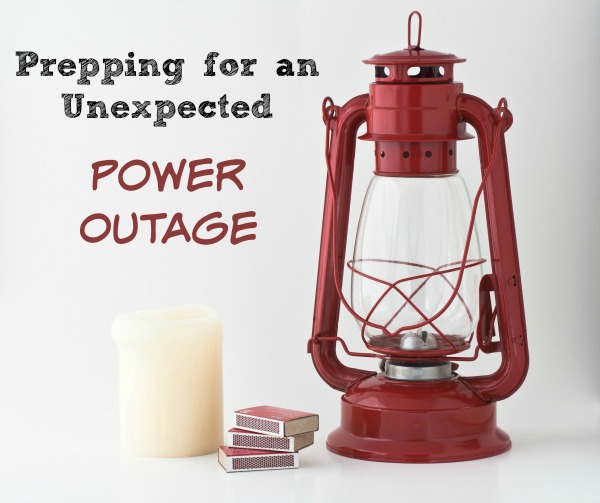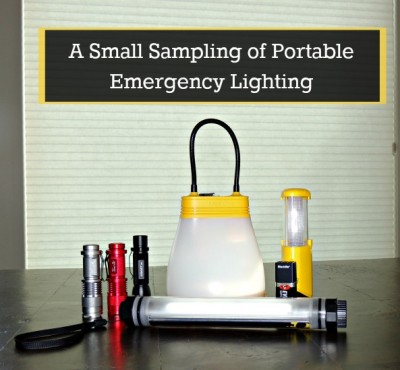Survival Basics: Prepping for An Unexpected Power Outage
 By Gaye Levy
By Gaye Levy
You don’t have to be a prepper to realize that power outages can happen anytime, to anybody, and anywhere. Some outages are planned, some are the result of Mother Nature kicking up a storm, and some are the unexpected result of a natural or man-made crisis. More recently, the threat of a cyber-attack or terrorist-invoked EMP has been added to the mix; and, most assuredly, if that were to happen we will be without power for an extended time.
The bottom line is this: the delicacy of our grid is such that nearly any disruption can cause a sudden and unexpected power outage.
Whatever the reason, there are various measures you should take now to ensure both your comfort and safety when the power blows unexpectedly. The good news is that prepper or not, most people already have the most basic power outage survival items on hand:
Flashlights
Batteries
Candles
Matches
Blankets
Widget not in any sidebars
Unless you have been living in a cocoon in Siberia, chances are that these items have already been set aside in your household so that they will be readily available when the lights blink off. For a 3- or 4-hour outage, you will be just fine with these basic supplies.
But what if the power is lost for a longer period of time? How will you cook your food? How will you keep warm? How will you ensure your safety and security in the dark? These are just a few of the issues you will face if there is an unexpected and extended power outage. Add infants, the elderly, or the infirm to the mix unless you have planned ahead, you will have a big problem and potential catastrophe on your hands.
Preparing in Advance For a Power Outage
Today I get back to survival basics and offer suggestions and ideas for prepping for an unexpected power outage. My goal is to get those wheels in your brain cranking, and to provide you with a list of suggestions that can be implemented in stages as your needs and budget allow.
1. Store foods that require very little in terms of warming or cooking. These foods should be items that your family normally eats. Suggestions? Canned meats, peanut butter, crackers, canned fruits and veggies, granola bars, and cold cereals. If you are a coffee drinker, include some instant coffee as well.
The list is endless but let me caution you: if you gag at the thought of cold ravioli out of a can now, you will also gag if you have to eat it in an emergency, power outage situation. Don’t be silly. Store foods that are meant to be eaten cold or at room temperature; or, if not, try sampling them in advance just to be sure. This may sound crazy but cold baked beans out of a can are actually quite good! Don’t forget the manual can opener and some disposable plates and utensils.
 2. Acquire one or more alternate cooking sources. You can cook outdoors using a fire pit, charcoal or propane barbeque, camp stove or even a DIY rocket stove.
2. Acquire one or more alternate cooking sources. You can cook outdoors using a fire pit, charcoal or propane barbeque, camp stove or even a DIY rocket stove.
We are lucky in that we have a propane cooktop in our kitchen that can easily be lit with a match. In addition, we have a Volcano Collapsible Cook Stove, an EcoZoom rocket stove, and three Solo Stoves. These devices provide options when it comes to using fuel not the least of which is biomass. We also have a cast iron fire pit that is set up for cooking, a couple of butane stoves, a gas grill, and a Sun Oven.
3. Store fuel for your chosen cooking method. Except for the Sun Oven, all require a source of fuel so don’t overlook having a supply on hand lest you take to chopping up the furniture to fuel the campfire.
This could be wood for the fire pit, propane cylinders for the gas grill, or 100 pounds of charcoal. It could also be a large bucket of pine cones or twigs to use as biomass in your rocket stove. The point is to store fuel because without question, you are going to need it. One more point: educate yourself on the proper storage of fuel. All of the food in the world will not help you one bit if you blow yourself to bits with fuel that has not be stored and used in a safe manner.
If propane is your fuel of choice, you will find lots of information and useful tips in the series Propane For Preppers, The Five Part Series.
 4. Have at least one good lantern plus lots of flashlights. Choose a lantern that will cast a wide beam and one that is large enough to fill a room with brightness when the sun goes down. We have both a Coleman propane lantern and a Coleman battery powered lantern. Coleman lanterns are a timeless choice because they last forever and replacement parts, even for older models, are readily available.
4. Have at least one good lantern plus lots of flashlights. Choose a lantern that will cast a wide beam and one that is large enough to fill a room with brightness when the sun goes down. We have both a Coleman propane lantern and a Coleman battery powered lantern. Coleman lanterns are a timeless choice because they last forever and replacement parts, even for older models, are readily available.
Solar lanterns are also useful and these days, many can be charged when the skies are overcast? My favorite is the Sun Bell which can also be used to charge a cell phone, Kindle, or other electronic device.
Then there are flashlights. Although they are pocket-sized, you can’t beat the price on these Mini-Crees (usually less than $4), the Coast HP1, and the Block-Lite. All right, I do have a flashlight fetish and just can’t help myself!
5. Stock supplies for bundling up. Blankets are good, but a nice toasty sleeping bag or down comforter is better. A heavy jacket and socks are good, too.
Plan to add layers for staying warm in a grid-down scenario. Long johns, covered by clothing and topped with a jacket will serve you well. Don’t forget hats, scarves, and fingerless gloves, so that you can stay warm and still function.
6. Invest in a gene rator. We invested in a 10 kw whole house generator that will automatically power our home during the frequent outages on our island. Think it won’t happen to you? A number of years back, the city of Seattle was dark for almost a week. It happens. After Superstorm Sandy hit the East Coast a few years ago, the power was down for weeks in parts of New York City.
rator. We invested in a 10 kw whole house generator that will automatically power our home during the frequent outages on our island. Think it won’t happen to you? A number of years back, the city of Seattle was dark for almost a week. It happens. After Superstorm Sandy hit the East Coast a few years ago, the power was down for weeks in parts of New York City.
I am not suggesting that you invest thousands of dollars in a whole house generator. For one, they take a lot of fuel. Also, installation by a qualified electrician is probably going to cost as much as the generator itself.
If you do go this route, make sure you test the installation! I can not stress this too much. After having my own generator installed, I was caught with no refrigerator power during a short-term outage because I stupidly trusted the electrician to get things right. Wrong. The wiring from the refrigerator to the master panel was not connected and we lost of lot of food, Whatever you do, test then test again every few months or so.
A portable generator can be purchased for as little as $500 or $600. If I were to do this again, I would skip the big, expensive unit and go with a portable unit. Rather than rely on a generator for power, I would much rather have the skill and determination to live without power for the duration of the outage.
There is one more caveat with generators. They can alert criminals that you are well prepared. Some generators are quite noisy, and your home will be a beacon in the darkness if it’s the only one lit up during an emergency. Depending where you live, caution is advised.
The last point that I want to make again lest you forget: be sure that you store plenty of fuel for your generator.
7. Consider solar power. If you have the proper sun exposure, the budget, and the space, solar power can be a backup to your local power grid. Many local utilities, states, and even the federal government offer financial incentives and policies that promote renewable energy. It is worth checking into.
8. Fill empty milk or juice jugs with water then store them in your freezer so that all of the spare nooks and crannies are filled. This will serve a variety of purposes, The freezer will operate more efficiently because it is full; plus, if there is an outage, the frozen jugs of ice will hold the contents cool for a longer period of time. You can even move some of the jugs of ice to your refrigerator to keep things cold for a short term following an unexpected outage.
Note: the water stored in this manner, when thawed, can be used for cleaning or flushing but not for drinking unless it is purified or filtered.
For more help understanding how to keep food safe during a power outage, read 11 Tips for Keeping Food Safe When the Power Goes Out.
Other Useful Stuff
We have covered basic power needs but what are some of the other essentials that you will want to have on hand during a power outage?
The following items will help you to sail through a power outage:
Battery operated or hand crank radio. Remember, without power, there may be no way to use your computers. Your DSL or cable service is likely to be kaput at well. This could be the only way you are able to get news.
Solar battery charger. Very handy for charging batteries to power flashlights and other battery powered devices.
Chemical light sticks. They more versatile than you might expect. (Here are 10 reasons you need them in your emergency kit.)
Amusements. Books, games, and playing cards. My favorite? A couple of decks of Canasta cards.
The Spirit of Adventure. Okay, I had to throw that in. Let’s face it, a positive attitude plus your emergency preps will help you soldier through an extended power outage.
The Final Word
I hope these ideas will start you on the road to thinking about an extended power outage and how you can prepare now to keep yourself warm, illuminated, comfortable if and when it happens. I also encourage you practice living without power for a day or even a weekend. That is the only way you will learn what you need to do to become better prepared.
I also suggest that you pop up a big pot of popcorn and get yourself a copy of the movie The Trigger Effect. I saw this film when it first came out and still find it chilling. Here a synopsis:
Do yourself a favor and buy some canned goods, a flashlight, and a radio before you watch this film.
Unfairly dismissed by the critics and missed by the public, this pre-Y2K suspense film is a chilling, sobering experience that will turn any practical person into a paranoid, apocalyptic loon. When the power goes out in the big city and society starts to break down, husband and wife Matthew and Annie find out that not even suburbia is safe.
If you still have have doubts, read One Second After or Cyberstorm. You will never think of a power outage in the same way again.
Enjoy your next adventure through common sense and thoughtful preparation!



